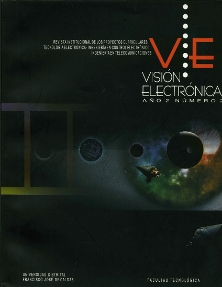DOI:
https://doi.org/10.14483/22484728.18391Publicado:
2018-08-13Número:
Vol. 1 Núm. 2 (2018): Edición especialSección:
Visión de CasoEstimation of conductivity in hydraulic affluents through self-organizing maps (SOM)
Predicción de la conductividad en afluentes hídricas mediante mapas auto-organizativos (SOM)
Palabras clave:
Redes neuronales artificiales, Minería de datos, Aprendizaje computacional, Mapas auto-organizativos (SOM), Conductividad en afluentes hídricas, Calidad del agua (es).Palabras clave:
Artificial neural networks, Data mining, Machine learning, Self-organizing maps (SOM), Water conductivity, Water quality (en).Descargas
Resumen (en)
This paper shows the use of self-organizing maps applied to water tributaries prediction. Currently, the environment conservation and the efficient water use, are pretty relevant issues. However, the water quality is not easy to measure, due to the specialized equipment for determining parameters such us: total coliforms, PH and dissolved oxygen. To measure the water conductivity, it was used a database with parameters of water quality, through the correlation of many involved parameters in water quality.
Resumen (es)
En este artículo se presenta el uso de mapas auto-organizativos aplicados a la predicción de afluentes hídricas. Actualmente, uno de los principales problemas es la preservación del medio ambiente y el uso eficiente del recurso hídrico. Sin embargo, la medición de la calidad del agua no es una tarea fácil, debido a lo especializado de los equipos para la determinación de parámetros tales como: coliformes totales, PH y oxígeno disuelto. Se empleó una base de datos con parámetros de calidad del agua para calcular la conductividad de la misma, a través de la correlación de varios parámetros involucrados en la calidad del agua.
Referencias
J. Refonaa, M. Lakshmi and V. Vivek, “Analysis and prediction of natural disaster using spatial data mining technique”, International Conference on Circuit, Power and Computing Technologies, 2015. https://doi.org/10.1109/ICCPCT.2015.7159379
C. Doña, N. Chang, V. Caselles, J. M. Sánchez, A. Camacho, J. Delegido and B. W. Vannah, “Integrated satellite data fusion and mining for monitoring lake water quality status of the Albufera de Valencia in Spain”, Journal of Environmental Management, vol. 151, 2015, pp. 416-426. https://doi.org/10.1016/j.jenvman.2014.12.003
G. Ssali and T. Marwala, “Computational intelligence and decision trees for missing data estimation”, IEEE International Joint Conference on Neural Networks (IEEE World Congress on Computational Intelligence), 2008. https://doi.org/10.1109/IJCNN.2008.4633790
M. K. Sohrabi and S. Akbari, “A comprehensive study on the effects of using data mining techniques to predict tie strength”, Computers in Human Behavior, vol. 60, 2016, pp. 534-541. https://doi.org/10.1016/j.chb.2016.02.092
Z. Yu, F. Haghighat and B. Fung, “Advances and challenges in building engineering and data mining applications for energy-efficient communities”, Sustainable Cities and Society, vol. 25, 2016, pp. 33-38. http://dx.doi.org/10.1016/j.scs.2015.12.001
S. Chapra, “Surface Water Quality Modelling”, Mc Graw Hill. Brown, L.C., and Barnwell, pp. 189, 1987.
S. Chapra, G. Pelletier and H. Tao, “QUAL 2K: A Modeling Framework for Simulating River and Stream Water Quality”, 2005. [Online]. Available at: https://www.hydroreform.org/node/3420
T. Garrido Reyes and J. Mendoza Crisosto, “Characterization of Dissolved Organic Matter in River Water by Conventional Methods and Direct Sample Analysis-Time of Flight-Mass Spectrometry”, Journal of Chemistry, vol. 2016, 2016. http://dx.doi.org/10.1155/2016/1537370
F. B. Wagner, P. Borch Nielsen, R. Boe-Hansen and H. Albrechtsen, “Copper deficiency can limit nitrification in biological rapid sand filters for drinking water production”, Water Research, vol. 95, 2016, pp. 280-288. http://dx.doi.org/10.1016/j.watres.2016.03.025
T. Umair Ali, Z. Ahmed and D. Kim, “Estimation of N2O emission during wastewater nitrification with activated sludge: Effect of ammonium and nitrite concentration by regression analysis”, Journal of Industrial and Engineering Chemistry, vol. 20, no. 4, 2014, pp. 2574-2579. http://dx.doi.org/10.1016/j.jiec.2013.10.042
A. Erturk, M. Gurel, A. Ekdal, C. Tavsan, A. Ugurluoglu, D. Zafer Seker, A. Tanik and I. Ozturk, “Water quality assessment and meta model development in Melen watershed – Turkey”, Journal of Environmental Management, vol. 91, no. 7, 2010, pp. 1526-1545. https://doi.org/10.1016/j.jenvman.2010.02.021
S. L. Nimmagadda and H. Dreher, "Ontology based data warehouse modeling and mining of earthquake data: prediction analysis along Eurasian-Australian continental plates," 5th IEEE International Conference on Industrial Informatics, Vienna, 2007, pp. 597-602. https://doi.org/10.1109/INDIN.2007.4384825
M. Bonansea, M. C. Rodriguez, L. Pinotti and S. Ferrero, “Using multi-temporal Landsat imagery and linear mixed models for assessing water quality parameters in Río Tercero reservoir (Argentina)”, Remote Sensing of Environment, vol. 158, 2015, pp. 28-41. https://doi.org/10.1016/j.rse.2014.10.032
E. Therese Harvey, S. Kratzer and P. Philipson, “Satellite-based water quality monitoring for improved spatial and temporal retrieval of chlorophyll-a in coastal waters”, Remote Sensing of Environment, vol. 158, 2015, pp. 417-430. https://doi.org/10.1016/j.rse.2014.11.017
X. Wang, J. Zhang and V. Babovic, “Improving real-time forecasting of water quality indicators with combination of process-based models and data assimilation technique”, Ecological Indicators, vol. 66, 2016, pp. 428-439. http://dx.doi.org/10.1016/j.ecolind.2016.02.016
G. Piatetsky-Shapiro, “Advances in knowledge discovery and data mining”, USA: American Association for Artificial Intelligence Menlo Park, 1996.
R. Salas, “Mapas Autoorganizativas de Kohonen (SOM)”, 2004. [Online]. Available at: http://www.inf.utfsm.cl/~rsalas/Pagina_Investigacion/docs/Apuntes/Redes%20SOM.pdf
J. Marín, “Mapas Auto-organizativos de Kohonen SOM”, 2008. [Online]. Available at: http://halweb.uc3m.es/esp/Personal/personas/jmmarin/esp/DM/tema5dm.pdf
A. Díaz, “Redes neuronales no supervisadas con topología dinámica de la segmentación de imágenes a color”, 2010. [Online]. Available at: http://agt.cie.uma.es/~adiaz/Publications/PFCAntonioDiazRamos.pdf
J. Rodríguez, “Fundamentos de la minería de datos”, Bogotá D.C, Colombia: Universidad Distrital Francisco José de Caldas, 2010.
F. Serrano, “Aplicación de mapas autoorganizados (SOM) a la visualización de datos”, 2009. [Online]. Available at: https://docplayer.es/9172902-Aplicacion-de-mapas-autoorganizados-som-a-la-visualizacion-de-datos-modelos-computacionales-fernando-jose-serrano-garcia.html
Cómo citar
APA
ACM
ACS
ABNT
Chicago
Harvard
IEEE
MLA
Turabian
Vancouver
Descargar cita
Licencia
Derechos de autor 2018 Visión electrónica

Esta obra está bajo una licencia internacional Creative Commons Atribución-NoComercial 4.0.
.png)
atribución- no comercial 4.0 International






.jpg)





